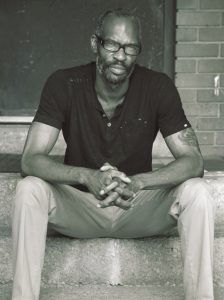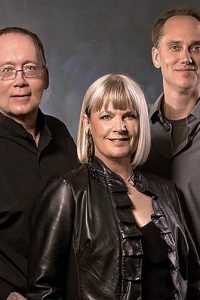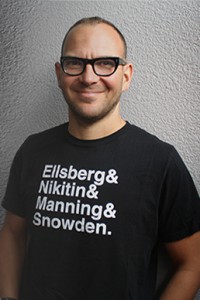Spotlight on: Ho Che Anderson

Born in London, England, Ho Che Anderson was named after the Vietnamese and Cuban revolutionaries Ho Chi Minh and Che Guevara. Anderson began his career as the author of numerous graphic novels, including King, a biography of the Reverend Doctor Martin Luther King, Jr.; the horror thriller Sand & Fury; and the science fiction action-adventure Godhead. Anderson wrote and directed his first feature in 2018, the supernatural heist thriller Le Corbeau, for Canada’s Telefilm, and is currently in development on a second feature. He also recently directed his first animated short, Governance 2020, for the National Film Board of Canada. Next up is the supernatural graphic novel, The Resurrectionists, for Abrams Books imprint Megascope, and another NeoText novella, Rizzo, following his latest release, Stone.
Tell us about your new novella Stone.
Stone is set in a world in which right-wing conservatism has reached the level of dictatorship, the kind of generational system of oppression Trump has been threatening the world with lately. It tells the story of Graciella O’Leary, who is gifted not only with athleticism and an indomitable work ethic, but also with great intelligence and a solid moral compass. She’s a grade-A student, but her true passion lies with basketball, and as the story opens she’s dedicated her life to becoming a pro baller, not only out of love for the game, but also as a means of moving beyond the poverty and oppression of her environment, which is a story as old as time, and still a relevant one. Unfortunately, her gifts are recognized by the Martin Family, her town’s local gentry if you will, and local representatives of the ruling Merit Party, irony intended. After a harrowing night in which the Martins essentially abduct Gracie and inform her in no uncertain terms that her life and skills now belong to them, that she will be reduced to an indentured servant slash high-end escort for the state, Gracie rebels and sets off on an adventure that will ultimately have serious consequences for this society. That’s not exactly an elevator pitch but it paints the basic picture.
You’re best known as a comic artist. Why did you decide to do Stone as a primarily prose work instead of a comic?
I love comics with all my heart, but they’ve never been the beginning and the end of what I’m interested in the creative arts. I’ve been a reporter, a commercial/editorial artist, a filmmaker, and I’ve written prose, and I’ve never considered myself a tourist in those fields: I studied them, practised them, and performed them to the best of my ability. Stone isn’t my original creation, it was an idea that was presented to me with the offer of taking custodianship of it and making the idea and its destiny my own, which I was happy to accept. It was a prose story when it was pitched to me and I took that as an opportunity to get back to a form of writing I highly respect and feel very comfortable in. There was a period in the mid-’90s when I was pursuing a career as a novelist and spent a lot of time developing my prose muscles, and it felt great to flex them again. During that period I published a short novel called The No-Boys Club, so this journey is something of a return to familiar terrain. I don’t know that I would’ve been as interested in this project if it had been presented as something for me to draw in comics. For me this story lands better as a prose piece over a chunk of comics storytelling.
Talk about your recent comics work. Godhead in particular seems like something our readers would enjoy.
Godhead is a two-volume, science fiction action-adventure. The first volume was published in 2018, and I’m 68 pages away from finishing volume two. It’s a story about what happens when a corporation creates a machine that allows the user to talk to God, thus allowing them to monetize faith and religion to an even greater degree than we have today. But shadowy players have a problem with the machine’s existence, which leads to the major conflict throughout the story. It’s a story that examines the corporate culture and its dominance in our lives; it’s about class warfare, religious dogma, architecture, water lore, robots and artificial intelligence, the effects of a life in the military post discharge, all wrapped up in a kind of men and women on a mission/Boy’s Own adventure. I threw a lot of personal obsessions into the mix, and Godhead is what emerged. Great fun – at least for me!
How did you get your start as an illustrator? What artists most influenced you?
I started drawing early. I can barely remember a time before I had a pencil in my hand and was creating scratches on a sheet of paper. Most kids eventually grow out of that and move on to more fruitful pursuits – my friends who drew pictures with me as a kid and are now highly successful are a testament to that – but for whatever reason I never did, and therein lies my gift and my curse. I got started as an illustrator by just drawing all the goddamn time and having it eventually dawn on me that I should try to get paid for it. I started in Toronto in the mid-’80s by knocking on the door of a local publisher called Vortex Comics and not leaving until they gave me some training. Then in the early ’90s I got my real start at Fantagraphics Books, writing and drawing indie comics. After that I started to move into the illustration world, one, to pay some bills and two, because I had a real love and admiration for the illustration world and the life of the illustrator, at least for a time. Contemporary Illustrators like Douglas Fraser, Gary Kelley, and Greg Manchess, and classic greats like Miguel Covarrubias and George Petty really got me excited, but that was an even tougher career to generate and sustain than comics was, even though the pay by the job was better. There was a ton of competition and getting those jobs on the regular was a challenge.
It would take many pages to list all the artists I’ve admired, loved, studied, and stolen from, but I can at least list a few of the majors. In comics the stuff that moved me the deepest came from Jack Kirby, Steve Ditko, Howard Chaykin, Frank Miller, Bill Sienkiewicz, Kyle Baker, Los Bros Hernandez, Steranko, John Byrne, Stelfreeze, Richard Corben, Herge, José Munoz, and I’m missing many heavy hitters.
In the fine art and illustration world, it was Gustav Klimt, Egon Schiele, Alphonse Mucha, JC Leyendecker, Richard Amsel, Aaron Douglas, Edgar Degas, Edward Hopper, Norman Rockwell, Tamara de Lempicka, Ludwig Hohlwein, and again, the list of greats I’m missing that affected me is far longer than what I’ve listed. There is a lot of talent in the history of the mediums.
It occurs to me, though, that my first hero in the arts was musical. I fell deeply in love with John Williams score to Star Wars as a child and it, as much as anything, is responsible for my life-long obsession with storytelling.
What’s more important – inspiration or perspiration? Is being an artist and author a higher calling, or a craft like any other?
Without question perspiration is the more important. Inspiration may be the gateway to a creating a hit project, but perspiration in my opinion is more important because perspiration is what will ensure you a long and sustainable career. Not many of us are capable of the kind of inspiration that propels you from journeyman to superstar. If you rely on inspiration, you’ll only attack your work when you’re in the mood, and the truth is you’re rarely in the mood relative to the amount of time you’ll need to finish a book or generate a real career. If that’s not what you’re after, no problem, but if you want to make being a creator an actual job as opposed to a hobby, that means developing the skills and mindset it takes to sit down and generate the words and the images even when you’d rather be doing something else. And as far as I’m concerned, it’s clearly a craft like any other. I can’t imagine someone being crazy enough to consider this work a higher calling. Being a surgeon is a higher calling. Being an activist and putting your life on the line for an ideal is a higher calling. Telling stories, not so much.
This spotlight and more like it in the October 2020 issue of Locus.
 While you are here, please take a moment to support Locus with a one-time or recurring donation. We rely on reader donations to keep the magazine and site going, and would like to keep the site paywall free, but WE NEED YOUR FINANCIAL SUPPORT to continue quality coverage of the science fiction and fantasy field.
While you are here, please take a moment to support Locus with a one-time or recurring donation. We rely on reader donations to keep the magazine and site going, and would like to keep the site paywall free, but WE NEED YOUR FINANCIAL SUPPORT to continue quality coverage of the science fiction and fantasy field.
©Locus Magazine. Copyrighted material may not be republished without permission of LSFF.








